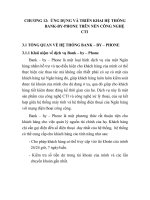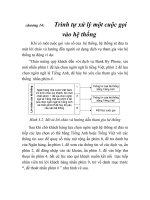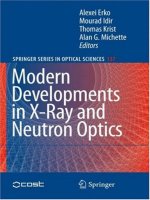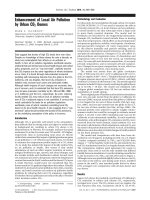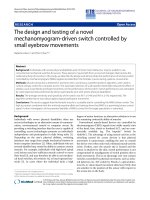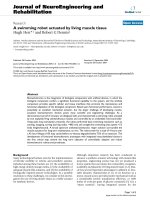Bygone Beliefs, by H. Stanley Redgrove docx
Bạn đang xem bản rút gọn của tài liệu. Xem và tải ngay bản đầy đủ của tài liệu tại đây (1.13 MB, 504 trang )
The Project Gutenberg EBook of Bygone
Beliefs, by H. Stanley Redgrove
This eBook is for the use of anyone
anywhere at no cost and with
almost no restrictions whatsoever. You
may copy it, give it away or
re-use it under the terms of the Project
Gutenberg License included
with this eBook or online at
www.gutenberg.org
Title: Bygone Beliefs
Author: H. Stanley Redgrove
Release Date: August 15, 2008 [EBook
#1271]
Language: English
*** START OF THIS PROJECT GUTENBERG EBOOK
BYGONE BELIEFS ***
Produced by Charles Keller, and David
Widger
BYGONE
BELIEFS BEING
A SERIES OF
EXCURSIONS
IN THE BYWAYS
OF THOUGHT
By H. Stanley
Redgrove
Alle Erfahrung ist Magic, und nur
magisch erklarbar.
NOVALIS (Friedrich von Hardenberg).
Everything possible to be believ'd is
an image of truth.
WILLIAM BLAKE.
TO MY WIFE
Transcriber's Note:
[.] = coordinate covalent bond.
[#s] = subscripted #.
[#S] = superscripted #.
{} mark non-ascii characters.
"Emphasis" italics have a * mark.
@@@ marks a reference to internal page
numbers.
Comments and guessed at characters in
{braces} need stripped/fixed.
Footnotes have not been re-numbered,
however, (#) are moved to EOParagraph.
The footnotes that have duplicate numbers
across 2 pages are "a" and "b".
"Protected" indentations have a space
before the [Tab].
EOL - have been converted to ([Soft
Hyphen]).
Greek letters are encoded in [gr ]
brackets, and the letters are
based on Adobe's Symbol font.
Hebrew letters are encoded in [hb ]
brackets.
THESE Excursions in the Byways of
Thought were undertaken at different times
and on different occasions; consequently,
the reader may be able to detect in them
inequalities of treatment. He may feel that
I have lingered too long in some byways
and hurried too rapidly through others,
taking, as it were, but a general view of
the road in the latter case, whilst
examining everything that could be seen in
the former with, perhaps, undue care. As a
matter of fact, how ever, all these
excursions have been undertaken with one
and the same object in view, that, namely,
of understanding aright and appreciating at
their true worth some of the more curious
byways along which human thought has
travelled. It is easy for the superficial
thinker to dismiss much of the thought of
the past (and, indeed, of the present) as
mere superstition, not worth the trouble of
investigation: but it is not scientific. There
is a reason for every belief, even the most
fantastic, and it should be our object to
discover this reason. How far, if at all, the
reason in any case justifies us in holding a
similar belief is, of course, another
question. Some of the beliefs I have dealt
with I have treated at greater length than
others, because it seems to me that the
truths of which they are the images—
vague and distorted in many cases though
they be—are truths which we have either
forgotten nowadays, or are in danger of
forgetting. We moderns may, indeed, learn
something from the thought of the past,
even in its most fantastic aspects. In one
excursion at least, namely, the essay on
"The Cambridge Platonists," I have
ventured to deal with a higher phase—
perhaps I should say the highest phase—of
the thought of a bygone age, to which the
modern world may be completely debtor.
"Some Characteristics of Mediaeval
Thought," and the two essays on Alchemy,
have appeared in The Journal of the
Alchemical Society. In others I have
utilised material I have contributed to The
Occult Review, to the editor of which
journal my thanks are due for permission
so to do. I have also to express my
gratitude to the Rev. A. H. COLLINS, and
others to be referred to in due course, for
permission here to reproduce illustrations
of which they are the copyright holders. I
have further to offer my hearty thanks to
Mr B. R. ROWBOTTOM and my wife for
valuable assistance in reading the proofs.
H. S. R.
BLETCHLEY, BUCKS, December
1919.
CONTENTS
PREFACE
BYGONE BELIEFS
I. SOME
CHARACTERISTICS OF
MEDAEVAL THOUGHT
II. PYTHAGORAS AND
HIS PHILOSOPHY
III. MEDICINE AND
MAGIC
IV. SUPERSTITIONS
CONCERNING BIRDS
V. THE POWDER OF
SYMPATHY: A CURIOUS
MEDICAL SUPERSTITION
VI. THE BELIEF IN
TALISMANS
VII. CEREMONIAL
MAGIC IN THEORY AND
PRACTICE
VIII. ARCHITECTURAL
SYMBOLISM
IX. THE QUEST OF THE
PHILOSOPHER'S STONE
X. THE PHALLIC
ELEMENT IN ALCHEMICAL
DOCTRINE
XI. ROGER BACON: AN
APPRECIATION
XII. THE CAMBRIDGE
PLATONISTS
BYGONE
BELIEFS
I. SOME
CHARACTERISTICS
OF MEDAEVAL
THOUGHT
IN the earliest days of his upward
evolution man was satisfied with a very
crude explanation of natural phenomena—
that to which the name "animism" has been
given. In this stage of mental development
all the various forces of Nature are
personified: the rushing torrent, the
devastating fire, the wind rustling the
forest leaves—in the mind of the animistic
savage all these are personalities, spirits,
like himself, but animated by motives
more or less antagonistic to him.
I suppose that no possible exception
could be taken to the statement that
modern science renders animism
impossible. But let us inquire in exactly
what sense this is true. It is not true that
science robs natural phenomena of their
spiritual significance. The mistake is often
made of supposing that science explains,
or endeavours to explain, phenomena. But
that is the business of philosophy. The task
science attempts is the simpler one of the
correlation of natural phenomena, and in
this effort leaves the ultimate problems of
metaphysics untouched. A universe,
however, whose phenomena are not only
capable of some degree of correlation, but
present the extraordinary degree of
harmony and unity which science makes
manifest in Nature, cannot be, as in
animism, the product of a vast number of
inco-ordinated and antagonistic wills, but
must either be the product of one Will, or
not the product of will at all.
The latter alternative means that the
Cosmos is inexplicable, which not only
man's growing experience, but the fact that
man and the universe form essentially a
unity, forbid us to believe. The term
"anthropomorphic" is too easily applied to
philosophical systems, as if it constituted
a criticism of their validity. For if it be
true, as all must admit, that the unknown
can only be explained in terms of the
known, then the universe must either be
explained in terms of man—i.e. in terms
of will or desire—or remain
incomprehensible. That is to say, a
philosophy must either be
anthropomorphic, or no philosophy at all.
Thus a metaphysical scrutiny of the
results of modern science leads us to a
belief in God. But man felt the need of
unity, and crude animism, though a step in
the right direction, failed to satisfy his
thought, long before the days of modern
science. The spirits of animism, however,
were not discarded, but were modified,
co-ordinated, and worked into a system as
servants of the Most High. Polytheism may
mark a stage in this process; or, perhaps,
it was a result of mental degeneracy.
What I may term systematised as
distinguished from crude animism
persisted throughout the Middle Ages. The
work of systematisation had already been
accomplished, to a large extent, by the
Neo-Platonists and whoever were
responsible for the Kabala. It is true that
these main sources of magical or animistic
philosophy remained hidden during the
greater part of the Middle Ages; but at
about their close the youthful and
enthusiastic CORNELIUS AGRIPPA
(1486-1535)(1) slaked his thirst thereat
and produced his own attempt at the
systematisation of magical belief in the
f a m o u s Three Books of Occult
Philosophy. But the waters of magical
philosophy reached the mediaeval mind
through various devious channels,
traditional on the one hand and literary on
the other. And of the latter, the works of
pseudo-DIONYSIUS,(2) whose immense
influence upon mediaeval thought has
sometimes been neglected, must certainly
be noted.
(1) The story of his life has been
admirably told by HENRY MORLEY (2
vols., 1856).
(2) These writings were first heard of
in the early part of the sixth century, and
were probably the work of a Syrian monk
of that date, who fathered them on to
DIONYSIUS the Areopagite as a pious
fraud. See Dean INGE'S Christian
Mysticism (1899), pp. 104—122, and
VAUGHAN'S Hours with the Mystics
(7th ed., 1895), vol. i. pp. 111-124. The
books have been translated into English by
the Rev. JOHN PARKER (2 vols.1897-
1899), who believes in the genuineness of
their alleged authorship.
The most obvious example of a
mediaeval animistic belief is that in
"elementals"—the spirits which personify
the primordial forces of Nature, and are
symbolised by the four elements,
immanent in which they were supposed to
exist, and through which they were held to
manifest their powers. And astrology, it
must be remembered, is essentially a
systematised animism. The stars, to the
ancients, were not material bodies like the
earth, but spiritual beings. PLATO (427-
347 B.C.) speaks of them as "gods".
Mediaeval thought did not regard them in
quite this way. But for those who believed
in astrology, and few, I think, did not, the
stars were still symbols of spiritual forces
operative on man. Evidences of the wide
extent of astrological belief in those days
are abundant, many instances of which we
shall doubtless encounter in our
excursions.
It has been said that the theological and
philosophical atmosphere of the Middle
Ages was "scholastic," not mystical. No
doubt "mysticism," as a mode of life
aiming at the realisation of the presence of
God, is as distinct from scholasticism as
empiricism is from rationalism, or "tough-
minded" philosophy (to use JAMES'
happy phrase) is from "tender-minded".
But no philosophy can be absolutely and
purely deductive. It must start from certain
empirically determined facts. A man might
be an extreme empiricist in religion (i.e. a
mystic), and yet might attempt to deduce
all other forms of knowledge from the
results of his religious experiences, never
caring to gather experience in any other
realm. Hence the breach between
mysticism and scholasticism is not really
so wide as may appear at first sight.
Indeed, scholasticism officially
recognised three branches of theology, of
which the MYSTICAL was one. I think
that mysticism and scholasticism both had
a profound influence on the mediaeval
mind, sometimes acting as opposing
forces, sometimes operating harmoniously
with one another. As Professor
WINDELBAND puts it: "We no longer
onesidedly characterise the philosophy of
the middle ages as scholasticism, but
rather place mysticism beside it as of
equal rank, and even as being the more
fruitful and promising movement."(1)
(1) Professor WILHELM
WINDELBAND, Ph.D.: "Present-Day
Mysticism," The Quest, vol. iv. (1913), P.
205.
Alchemy, with its four Aristotelian or
scholastic elements and its three mystical
principles—sulphur, mercury, salt,—must
be cited as the outstanding product of the
combined influence of mysticism and
scholasticism: of mysticism, which
postulated the unity of the Cosmos, and
hence taught that everything natural is the
expressive image and type of some
supernatural reality; of scholasticism,
which taught men to rely upon deduction
and to restrict experimentation to the
smallest possible limits.
The mind naturally proceeds from the
known, or from what is supposed to be
known, to the unknown. Indeed, as I have
already indicated, it must so proceed if
truth is to be gained. Now what did the
men of the Middle Ages regard as falling
into the category of the known? Why,
surely, the truths of revealed religion,
whether accepted upon authority or upon
the evidence of their own experience. The
realm of spiritual and moral reality: there,
they felt, they were on firm ground. Nature
was a realm unknown; but they had
analogy to guide, or, rather, misguide
them. Nevertheless if, as we know, it
